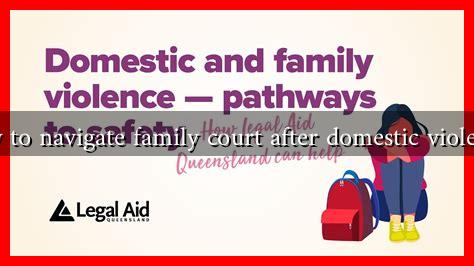-
Table of Contents
How to Navigate Family Court After Domestic Violence
Domestic violence is a harrowing experience that can leave survivors feeling isolated and overwhelmed, especially when it comes to navigating the complexities of family court. Understanding the legal landscape and knowing your rights can empower survivors to seek justice and protection for themselves and their children. This article provides a comprehensive guide on how to effectively navigate family court after experiencing domestic violence.
Understanding Domestic Violence and Its Legal Implications
Domestic violence encompasses a range of abusive behaviors, including physical, emotional, and psychological abuse. According to the National Coalition Against Domestic Violence (NCADV), nearly 1 in 4 women and 1 in 9 men experience severe intimate partner physical violence. Understanding the legal implications of domestic violence is crucial for survivors seeking protection and justice.
Steps to Take Before Entering Family Court
Before stepping into the family court system, survivors should take several important steps to prepare:
- Document Everything: Keep a detailed record of incidents, including dates, times, and descriptions of the abuse. Photographs of injuries and copies of police reports can serve as vital evidence.
- Seek Legal Assistance: Consult with a lawyer who specializes in domestic violence cases. Organizations like the National Network to End Domestic Violence can help connect you with legal resources.
- Obtain a Restraining Order: If you feel threatened, consider applying for a restraining order to legally prohibit the abuser from contacting you.
- Gather Support: Reach out to friends, family, or support groups. Emotional support is crucial during this challenging time.
Understanding Family Court Processes
Family court can be intimidating, especially for those unfamiliar with the legal system. Here’s what to expect:
- Filing for Custody: If children are involved, you may need to file for custody. Courts prioritize the safety and well-being of children, often considering the history of domestic violence.
- Temporary Orders: You can request temporary orders for custody, visitation, and support while the case is ongoing.
- Mediation: Some courts may require mediation to resolve disputes. Be cautious, as mediation may not be appropriate in cases involving domestic violence.
- Trial: If an agreement cannot be reached, the case will go to trial, where both parties present evidence and witnesses.
Presenting Your Case Effectively
When presenting your case in family court, clarity and organization are key. Here are some tips:
- Be Prepared: Organize your documentation and evidence. Create a timeline of events to present a clear narrative.
- Stay Calm: Emotions can run high in court. Practice staying calm and composed, even when discussing painful experiences.
- Use Witnesses: If possible, bring witnesses who can corroborate your story or provide character references.
- Focus on the Children: Always frame your arguments around the best interests of the children involved.
Post-Court Considerations
After the court proceedings, it’s essential to take additional steps to ensure your safety and well-being:
- Follow Court Orders: Adhere to any court orders regarding custody and visitation to avoid legal repercussions.
- Continue Support Services: Engage with counseling or support groups to help process your experiences and maintain emotional health.
- Stay Vigilant: Remain aware of your surroundings and consider additional safety measures, such as changing locks or using a safety app.
Conclusion
Navigating family court after experiencing domestic violence is undoubtedly challenging, but with the right preparation and support, survivors can advocate for their rights and the safety of their children. By documenting incidents, seeking legal assistance, and understanding the court process, survivors can empower themselves to seek justice. Remember, you are not alone; numerous resources and organizations are available to support you through this difficult journey.
For more information on domestic violence resources, visit the National Coalition Against Domestic Violence.

